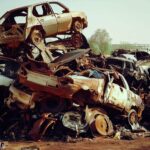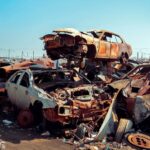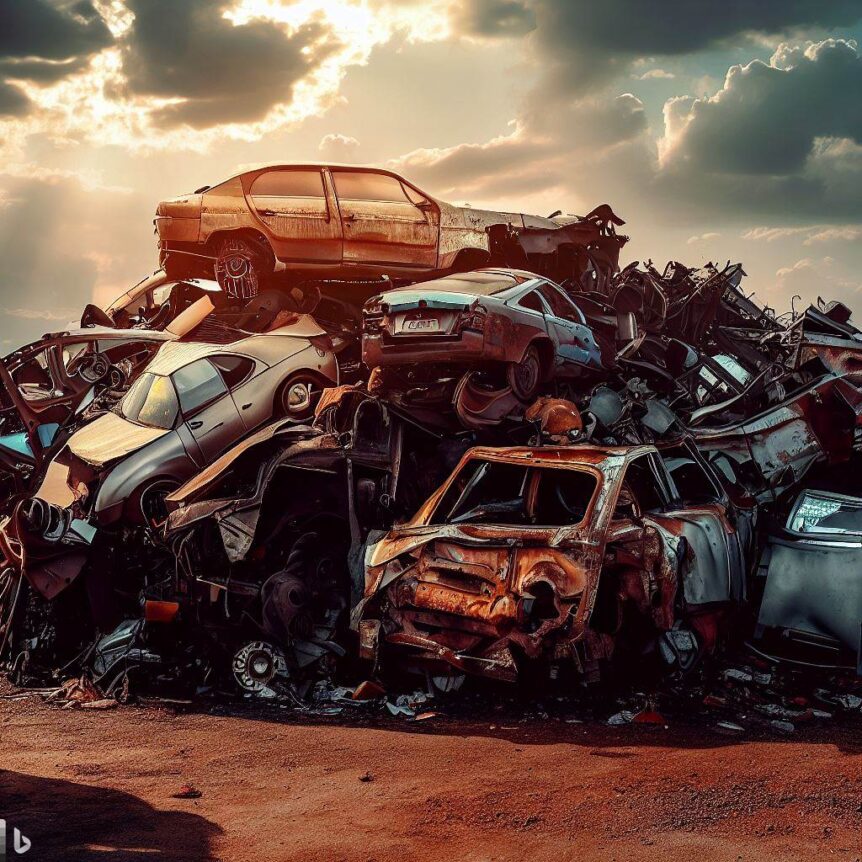Junk cars, also known as end-of-life vehicles (ELVs), go through a systematic process when they reach scrapyards. These facilities play a crucial role in recycling and disposing of old automobiles in an environmentally responsible manner. In this article, we will explore the typical treatment process for junk cars scrapyards.
I. Vehicle Reception and Documentation
Upon arrival at a scrapyard, junk cars undergo a meticulous reception process that encompasses comprehensive documentation and thorough assessment. The highly trained and experienced scrapyard staff diligently record vital details, including the vehicle identification number (VIN), make, model, and condition. This meticulous documentation serves multiple purposes, such as facilitating efficient tracking of the vehicle’s history and ensuring compliance with legal requirements.
The initial step the reception process involves carefully documenting the VIN, a unique identifier that provides crucial information about the vehicle’s origin, manufacturing specifications, and ownership history. By recording this essential detail, the scrapyard establishes a reliable reference point for future inquiries or investigations related to the vehicle.
In addition to the VIN, the make and model of the junk car are meticulously recorded. This information not only aids in categorizing and organizing the vehicles within the scrapyard but also assists potential buyers salvage operators in identifying specific parts or components they may require.
Furthermore, the condition of the vehicle thoroughly assessed and documented. This evaluation includes an examination of both the exterior and interior aspects, encompassing factors such as body damage, mechanical functionality, and the presence of any hazardous materials. Accurate documentation of the vehicle’s condition ensures transparency and helps potential buyers or recyclers make informed decisions based on their specific needs and requirements.
Moreover, the comprehensive documentation performed during the reception process plays a pivotal role in complying with legal obligations. recording essential details, the scrapyard adheres to regulations governing the disposal and recycling of junk cars, ensuring environmental sustainability and minimizing potential liabilities.
The reception process at a scrapyard involves meticulous documentation and assessment of junk cars. Through the recording of vital details such as the VIN, make, model, and condition, the scrapyard facilitates efficient tracking of the vehicle’s history, assists in part identification, and ensures compliance with legal requirements.
Source: National Highway Traffic Safety Administration

II. Fluid Drainage and Component Removal
Proper fluid drainage and component removal are essential steps in the processing of junk cars to ensure environmental safety and maximize resource utilization. To prevent any potential environmental contamination, it crucial to drain the fluids present in these vehicles before proceeding with further processing.
Highly skilled scrapyard technicians meticulously carry out the task of removing various fluids, including engine oil, transmission fluid, coolant, and brake fluid. By doing so, they effectively eliminate the risk of these substances seeping into the environment and causing harm. This responsible approach not only safeguards ecosystems but also aligns with sustainable practices.
Moreover, in addition to fluid drainage, valuable components within the junk cars are carefully extracted for separate recycling or resale purposes. These components often include batteries, catalytic converters, and tires. By salvaging and recycling these items, the scrapyard contributes to reducing waste and conserving resources. Furthermore, the resale of functional components allows for their reuse, promoting a circular economy and minimizing the need for new production.
By prioritizing fluid drainage and component removal, the scrapyard demonstrates its commitment to environmental stewardship and resource efficiency. Through these meticulous processes, the facility ensures that harmful substances are properly disposed of, while valuable materials are recovered and given a second life. This comprehensive approach not only benefits the environment but also supports the sustainable management of automotive waste.
Source: Environmental Protection Agency

III. Dismantling and Parts Sorting
Commencing after the extraction of essential fluids and components, the dismantling process is initiated. Proficient workers skillfully disassemble the discarded vehicles, meticulously segregating them into distinct parts and materials. This crucial stage entails categorizing the components according to their condition and determining their potential for reuse or recycling. Components of significant value can marketed to auto repair shops or individuals, while the remaining materials are readied for subsequent processing.
During the dismantling phase, the skilled workforce employs their expertise to carefully deconstruct the junk cars, ensuring that each part is separated with precision. By systematically categorizing the components, they facilitate efficient management of the salvageable resources. This meticulous sorting process involves evaluating the condition of each part, assessing its usability, and identifying any potential defects or damages.
The categorization of components based on their condition and potential for reuse or recycling is a vital step in the overall recycling process. It allows for the identification of valuable parts that can salvaged and sold to auto repair shops individuals seeking affordable alternatives. These high-quality components not only contribute to the circular economy but also provide cost-effective solutions for vehicle repairs.
Simultaneously, the remaining materials that do not hold immediate value are prepared for further processing. These materials undergo additional treatment to extract any residual value or to transform them into raw materials suitable for various industries. By preparing these materials for subsequent stages, the recycling process maximizes resource recovery and minimizes waste generation.
The dismantling and parts sorting phase plays a pivotal role in the automotive recycling process. Through the expertise of skilled workers and meticulous categorization, valuable components are identified for resale, while the remaining materials are readied for further processing, ensuring optimal resource utilization and environmental sustainability.

IV. Scrap Metal Recycling
Scrap metal recycling plays a crucial role in the overall process of junk car treatment within scrapyards. Once the initial dismantling is complete, the remaining metal components, including the chassis and body panels, undergo a series of steps to transform them into usable materials. Specialized machinery is employed to compact these metal scraps into smaller pieces, facilitating their transportation to dedicated recycling facilities.
At these recycling facilities, the metal scraps are subjected to various processes such as shredding, melting, and purification. These steps are essential for transforming the scraps into high-quality raw materials that can be utilized by manufacturing industries. Shredding involves breaking down the metal scraps into smaller fragments, increasing their surface area and making them easier to handle during subsequent stages.
Following shredd, the metal fragments are melted down to eliminate impurities and separate different types of metals. This melting process allows for the creation of homogeneous metal alloys or the extraction of specific metals for further refinement. Purification techniques are then employed to remove any remaining contaminants, ensuring the resulting raw materials meet industry standards and specifications.
The recycled metal obtained from this comprehensive recycling process serves as a sustainable alternative to virgin materials. By reusing these resources, the demand for new mining activities and the associated environmental impact can be significantly reduced. Additionally, scrap metal recycling helps conserve energy and reduce greenhouse gas emissions compared to traditional manufacturing processes.
Scrap metal recycling is an integral part the junk car treatment process within scrapyards. Through specialized machinery and various refining techniques, the metal scraps are transformed into high-quality raw materials, contributing to sustainable manufacturing practices and environmental preservation.
Source: Institute of Scrap Recycling Industries

V. Environmental Considerations
Scrapyards place a paramount emphasis on environmental considerations throughout the entire treatment process. They diligently adhere to regulations established by local authorities and environmental agencies, aiming to minimize pollution and foster sustainability. The proper disposal of hazardous materials, prevention of soil and water contamination, and strict compliance with air quality standards are pivotal aspects of junk car treatment within scrapyards.
Environmental responsibility stands as a core value for scrapyards, guiding their operations and decision-making processes. prioritizing sustainable practices, these facilities actively contribute to the preservation and protection of our natural resources. Through meticulous adherence to local regulations, they ensure that their activities do not pose any harm to the environment or surrounding communities.
One the primary objectives of scrapyards the safe and responsible disposal of hazardous materials. These facilities employ specialized techniques and equipment to handle and dispose of such substances in accordance with established guidelines. By doing so, they prevent the release of harmful chemicals into the environment, safeguarding both human health and ecological integrity.
Furthermore, scrapyards take proactive measures to prevent soil and water contamination. They implement robust containment systems and employ best practices to prevent any leakage or seepage of pollutants from junk cars. This commitment to preventing contamination helps maintain the quality and purity of soil and water resources, preserving ecosystems and supporting biodiversity.
In addition to managing hazardous materials and preventing contamination, scrapyards also prioritize compliance with air quality standards. They employ advanced technologies and emission control measures to mitigate the release pollutants into the atmosphere. strictly adhering to air quality regulations, scrapyards contribute to reducing air pollution and improving overall air quality in their vicinity.
Scrapyards demonstrate a steadfast commitment to environmental responsibility. Their adherence to regulations, proper disposal of hazardous materials, prevention of soil and water contamination, and compliance with air quality standards collectively contribute to sustainable junk car treatment. By upholding these crucial aspects, scrapyards play a vital role in protecting the environment and promoting a greener future.
Source: United States Environmental Protection Agency

Conclusion
Junk cars receive comprehensive treatment in scrapyards, ensuring proper disposal, recycling, and resource recovery. Through the systematic processes of reception, fluid drainage, dismantling, parts sorting, and scrap metal recycling, these facilities contribute to reducing waste and minimizing the environmental impact of end-life vehicles. By following strict guidelines and regulations, scrapyards play a vital role in sustainable automotive waste management.




